Trying to improve employee engagement without an action plan is like fixing a leaky faucet with a spoon—you might slow the drip, but you’re not getting to the root of the problem. Without a clear, step-by-step approach, even the best intentions fall flat. Follow along to access an employee engagement action plan that gives you the structure to move from guesswork to real, measurable impact.
Employee disengagement isn’t a quiet problem. It shows up in missed deadlines, eye rolls in Zoom calls, and high turnover. And while you can’t control every factor (like economic uncertainty or industry burnout), you can take control of the employee experience. That’s the beauty of action planning: it turns vague feelings into clear steps.
It’s not about overhauling your culture overnight—it’s about knowing where to focus, what to prioritize, and how to follow through. A well-built action plan gives you direction, accountability, and momentum, so your engagement efforts aren’t just reactive—they’re repeatable.
In this guide, you’ll learn exactly what an employee engagement action plan is, why it matters, and how to build one that actually moves the needle—step by step. Let’s get into it.
Take self-guided tour of ContactMonkey
See how our key features can streamline your internal communications.
Take product tour

Why Is Employee Engagement So Important?
Employee engagement is what happens when people feel connected to their work, team, and purpose. Engaged employees are more productive, more likely to stay, and generally contribute more to the company’s goals.
Disengaged employees, on the other hand, cost companies billions each year through absenteeism, poor performance, and attrition. That’s why every forward-thinking company needs an action plan to improve employee engagement—because hope is not a strategy.
What Is an Employee Engagement Action Plan?
An employee engagement action plan is a structured approach to identifying areas of low engagement, setting goals to improve them, and implementing measurable strategies. It’s not just a list of “fun ideas.” It’s a feedback-informed, results-driven plan that aligns with business goals.
Think of it as your custom playbook to build better communication, stronger culture, and more motivated teams.
Key Benefits of Creating an Employee Engagement Action Plan
Before we get to the how, let’s talk about the why. Here’s why you should carve out time to build a solid employee engagement action plan:
- Boost retention: Employees who feel heard and supported stick around.
- Improve performance: Engagement correlates with productivity.
- Foster trust: Following through on feedback builds transparency.
- Make data work for you: Turning employee engagement survey results into action helps you move from analysis to actual change.
- Create accountability: A documented action plan for employee engagement keeps managers and teams aligned.
Whether you’re a 500-person org or a fast-growing startup, a simple plan can bring structure to chaos—and momentum to culture-building.
Start two-way conversations and employee feedback loops
Learn how to engage staff with pulse surveys, content ratings and reactions, custom polls, and more. Ready to send modern emails?
See engagement features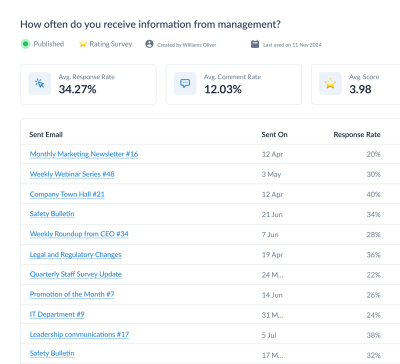
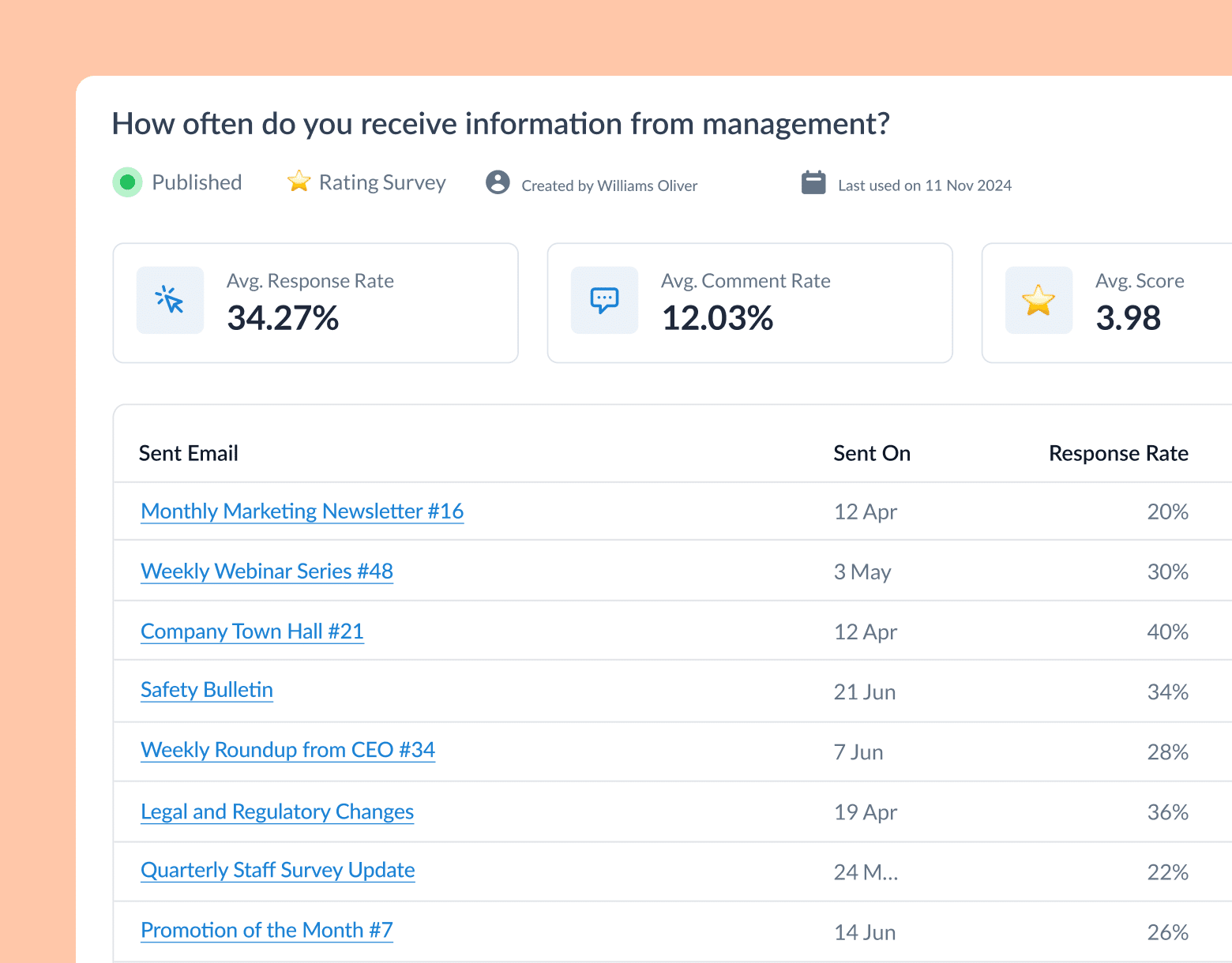
10 Steps to Create a Successful Employee Engagement Action Plan
These 10 steps will help you craft a meaningful, measurable, and manageable employee engagement action plan that sticks.
1. Review your current engagement levels
You can’t improve what you don’t understand. Before building your employee engagement action plan, take a deep dive into your existing data. This baseline will help you identify where your employees are thriving—and where they’re tuning out.
Questions to answer for this step:
- What areas of engagement are currently thriving or underperforming?
- Are there patterns across departments, roles, or locations?
- Have engagement levels improved, declined, or plateaued since the last survey?
Actionable tips to execute:
- Review the last 6–12 months of employee engagement survey data.
- Segment responses by demographics, role, or location.
- Analyze both scores and open-ended responses.
Considerations:
- Ensure anonymity to get honest feedback.
- Be cautious of recency bias—look for longer-term trends.
BONUS: Use this guide on creating an action plan for employee engagement survey results to understand how to implement strategies that address employee feedback.
2. Identify patterns and problem areas
After gathering your data, the next step is pattern recognition. Your goal here is to spot engagement red flags and recurring issues that need to be addressed in your plan. Look beyond scores—what are the stories hiding in the feedback?
Questions to answer for this step:
- What engagement challenges keep showing up across teams?
- Are there visible correlations between feedback and turnover or burnout?
- Which areas have improved or worsened significantly?
Actionable tips to execute:
- Use heatmaps to visualize high/low scoring areas.
- Cross-reference engagement data with HR metrics (turnover, absenteeism).
- Conduct follow-up interviews or quick polls to validate concerns.
Considerations:
- Don’t overgeneralize from small groups.
- Combine hard data with anecdotal feedback for a fuller picture.
BONUS: How do you effectively analyze employee survey results? This piece breaks down key steps to conduct employee survey analysis.
Watch ContactMonkey LIVE in action
Join live demo
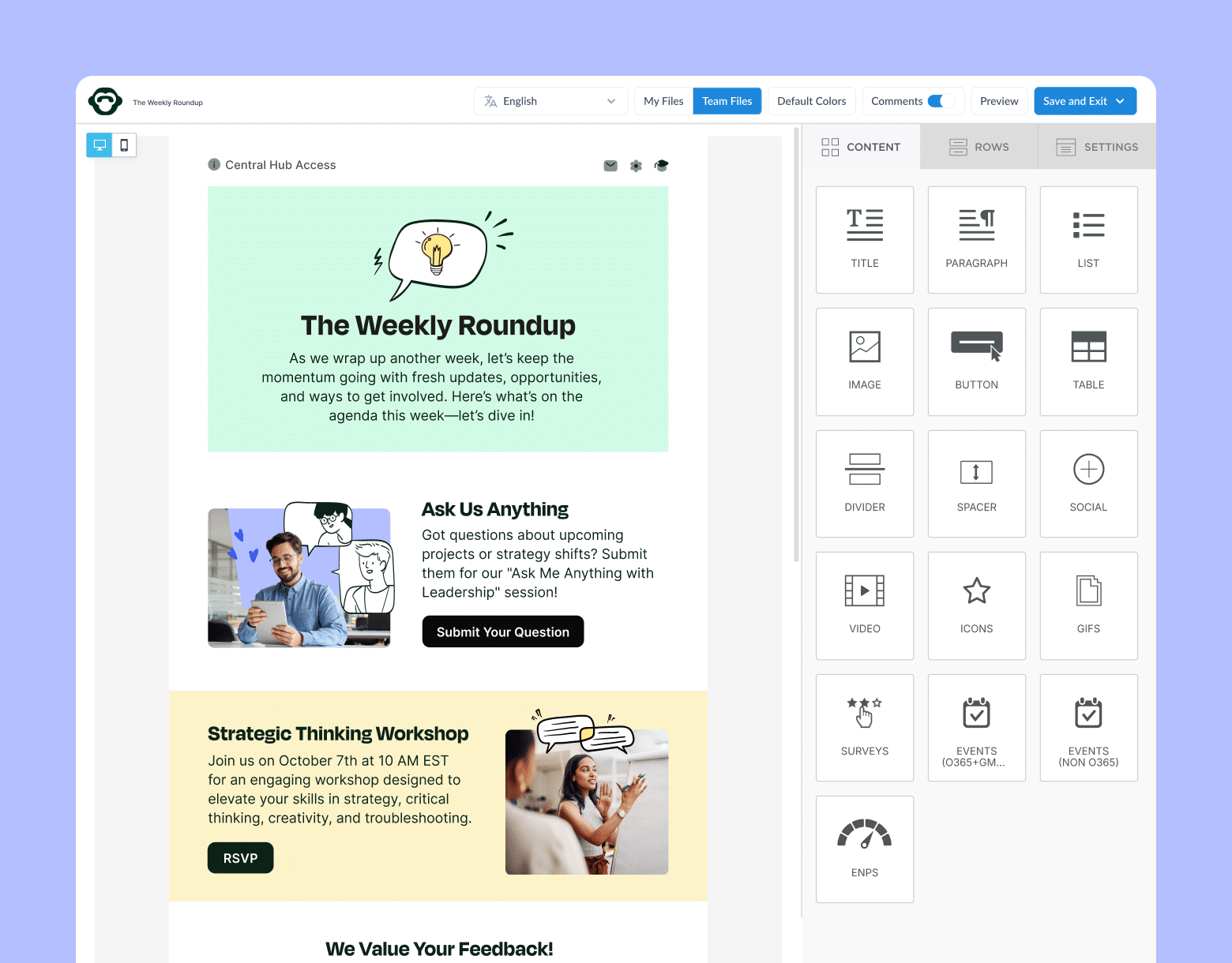
3. Prioritize key focus areas for your employee engagement action planning
Too many goals = no real progress. Focus your employee engagement action plan on the 1–3 areas that will make the biggest impact. This makes your plan more actionable, realistic, and measurable.
Questions to answer for this step:
- What issues are most urgent or painful for employees?
- Where can you make visible progress in the short term?
- Which areas align with business priorities?
Actionable tips to execute:
- Score focus areas based on urgency and potential impact.
- Narrow your list through a team workshop or leadership discussion.
- Start with one foundational issue and one quick-win item.
Considerations:
- Not everything is urgent—look for strategic leverage points.
- Make sure leadership and team managers buy into your focus areas.
4. Set clear, measurable goals for your employee engagement action plan
Now that you’ve picked your focus areas, it’s time to turn them into goals. Vague intentions like “increase morale” won’t get results. Clear, trackable objectives are the foundation of any strong action plan to improve employee engagement.
Questions to answer for this step:
- What would success look like in each focus area?
- How will you measure progress and impact?
- What’s the timeline for reaching each goal?
Actionable tips to execute:
- Use the SMART framework to define your internal communication goals.
- Tie each goal to specific engagement survey questions.
- Establish baseline metrics before launching initiatives.
Considerations:
- Choose metrics you can realistically measure.
- Set checkpoints to adjust as you go.
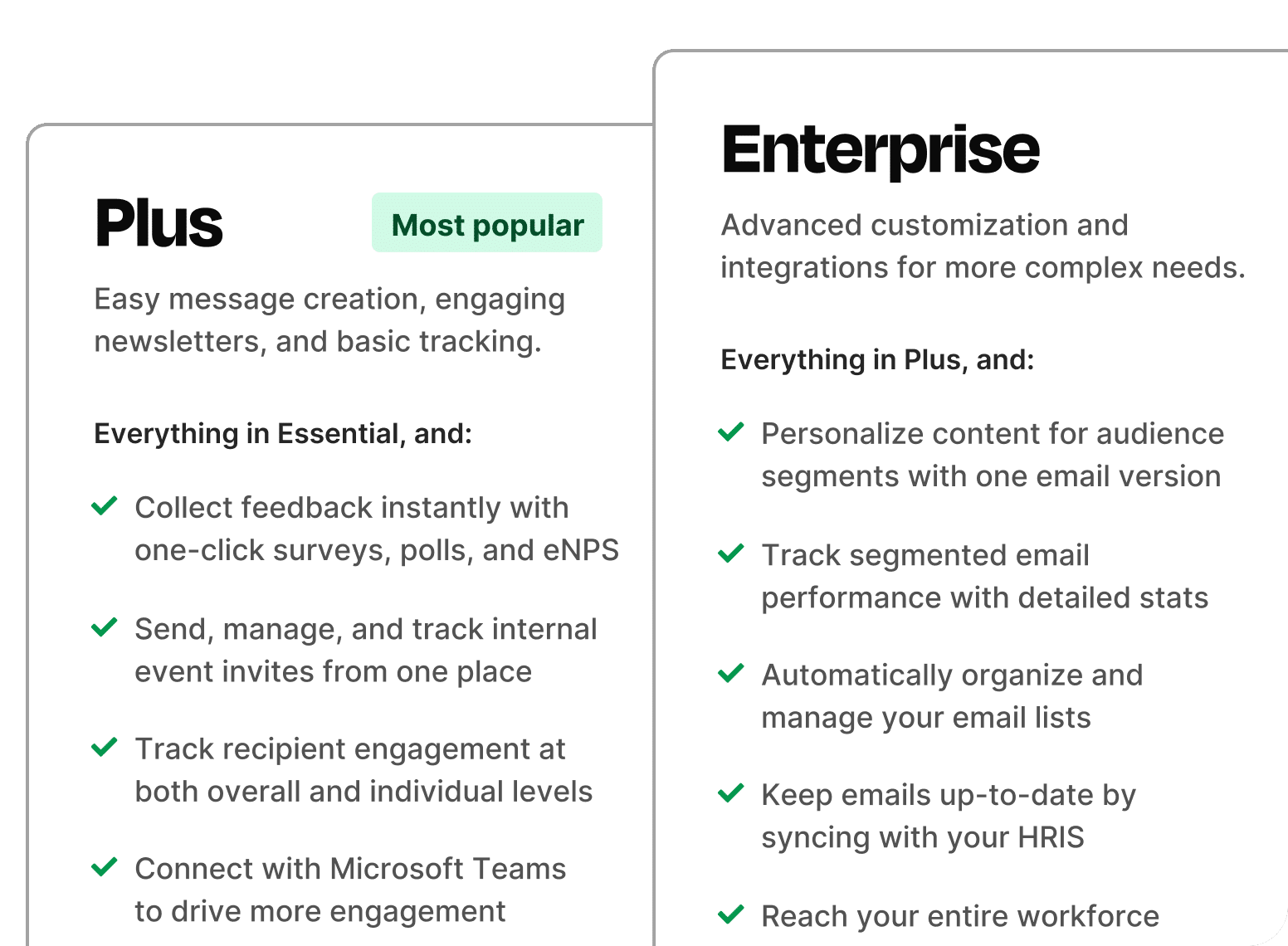
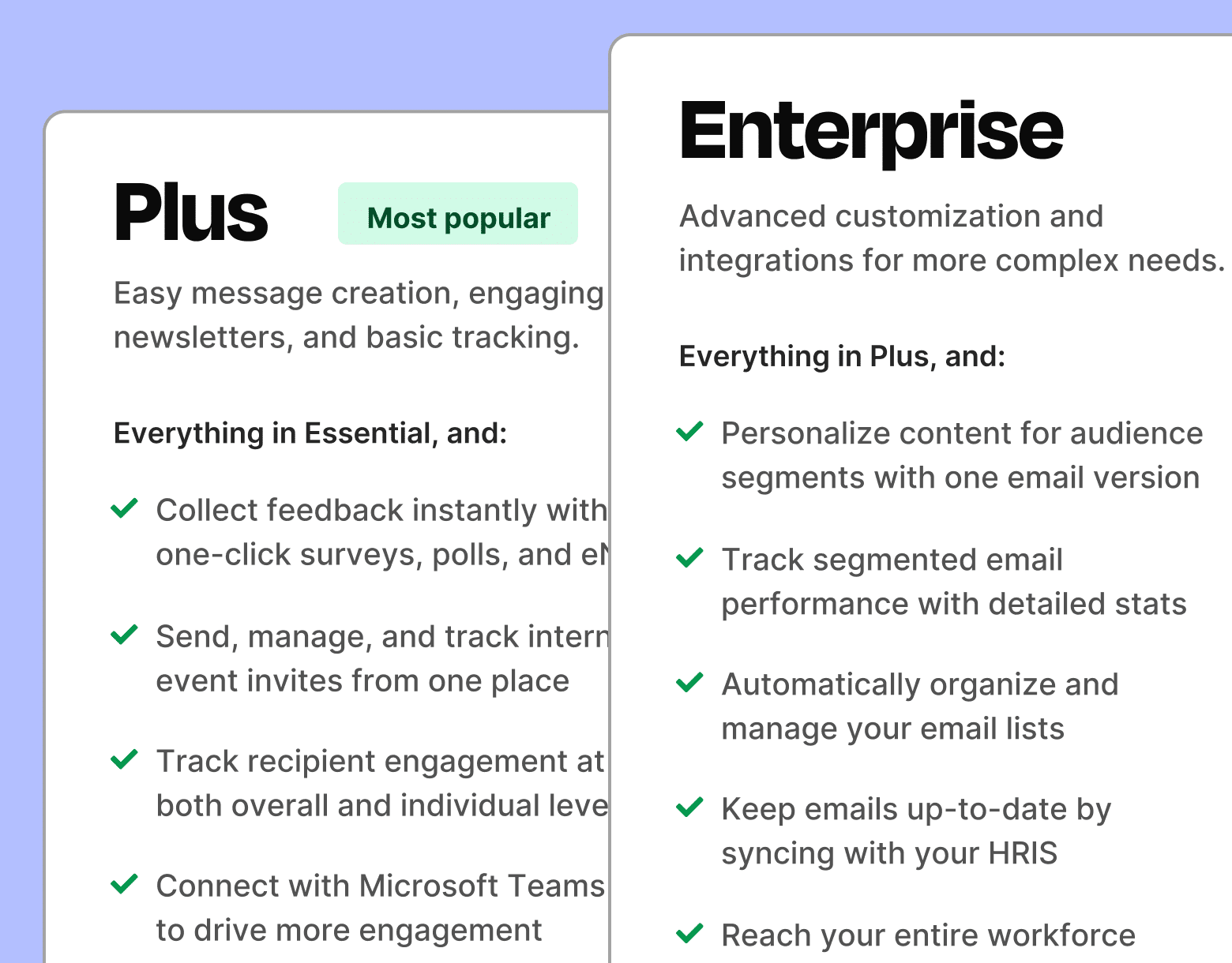
5. Map out your employee engagement action plan steps
A goal without a plan is just a wish. For each engagement goal, outline the specific actions you’ll take. These steps bring your employee engagement action plan to life and make it executable.
Questions to answer for this step:
- What exact steps will we take to meet this goal?
- Who will be responsible for each step?
- What tools, budget, or time commitments are required?
Actionable tips to execute:
- List 2–5 tactical items per goal.
- Use a Gantt chart or action planning board to track tasks.
- Share the plan with relevant teams for feedback.
Considerations:
- Action steps should be easy to understand and execute.
- Include a mix of quick wins and long-term changes.
6. Assign ownership for your employee engagement action plan
Without clear accountability, plans stall. Assign specific individuals or teams to own each step of your employee engagement action plan. When everyone knows who’s doing what, it’s easier to track progress and stay aligned.
Questions to answer for this step:
- Who is the right person to lead each initiative?
- Do they have the capacity and authority to own it?
- How will they report on progress?
Actionable tips to execute:
- Assign owners during your initial planning meetings.
- Build ownership into individual and team OKRs.
- Celebrate those who lead engagement efforts.
Considerations:
- Avoid overburdening high performers—spread ownership.
- Provide resources or support where needed.
7. Communicate the plan to employees
Your action plan for employee engagement only matters if employees know about it. Communicate your goals, timeline, and rationale openly. Let people know that their feedback inspired the change.
Questions to answer for this step:
- What channels will we use to announce the plan?
- How do we make it feel employee-led, not top-down?
- What’s our cadence for updates?
Actionable tips to execute:
- Launch the plan in a dedicated email with key points summarized.
- Include a short video from leadership explaining the “why.”
- Host a virtual town hall to answer questions.
Considerations:
- Keep messaging human, not corporate.
- Be honest about what’s being prioritized and why.
BONUS: To understand which channels are most effective to communicate your action plan, consider developing an internal communication channel matrix that serves like a GPS system.
Create and send employee surveys for feedback
Engage staff with pulse surveys, eNPS surveys, reusable surveys, custom polls, and more. Ready to send modern emails?
Explore survey features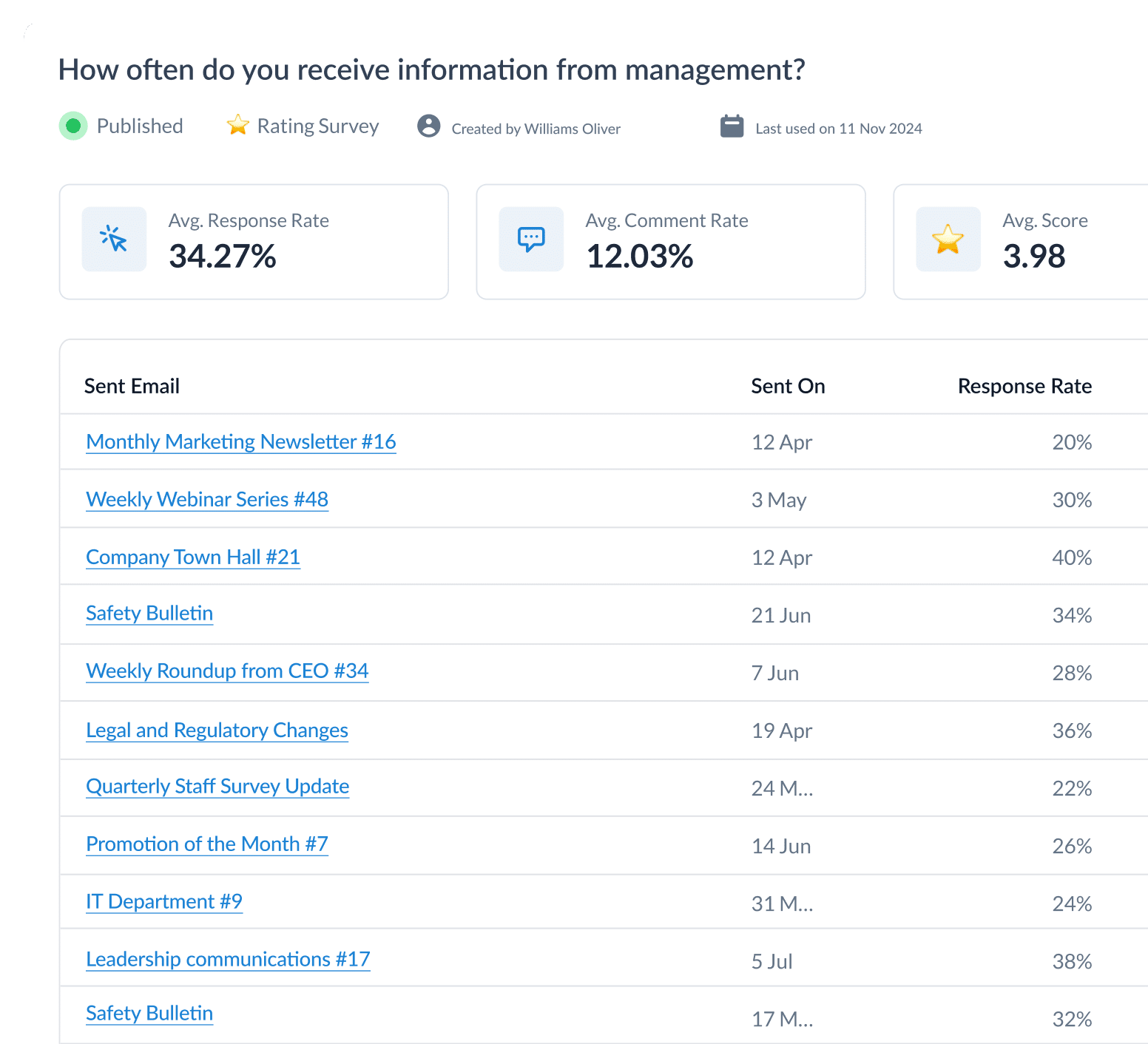

8. Make it easy to give feedback
A good employee engagement action plan stays alive through two-way communication. Keep feedback flowing after the plan is launched so you can improve and iterate based on real input.
Questions to answer for this step:
- What feedback mechanisms are currently in place?
- How often do we ask for employee input?
- Are employees confident their voices will be heard?
Actionable tips to execute:
- Schedule regular pulse surveys post-launch.
- Offer anonymous digital suggestion boxes.
- Encourage managers to ask for informal feedback in 1:1s.
Considerations:
- Normalize giving feedback—don’t wait for crises.
- Follow up with “you said, we did” updates to build trust.
PRO TIP: Use employee engagement software like ContactMonke to embedded emoji or 1-click sentiment tools inside newsletters to reduce friction and increase response rates.
9. Track and measure progress
Measurement turns guesswork into insight. Track how your initiatives are performing and whether they’re moving the needle on your goals. This will help you adapt and prove ROI over time.
Questions to answer for this step:
- What KPIs will we monitor and how often?
- Are we seeing improvement in target areas?
- What’s not working—and why?
Actionable tips to execute:
- Reissue key employee engagement survey questions at regular intervals.
- Monitor open and click rates on engagement-related communications.
- Log progress in a shared dashboard.
Considerations:
- Compare data over time, not just point-to-point.
- Involve team leads in reviewing the data to spark insights.
10. Celebrate wins and adapt as needed
Momentum matters. Celebrate the small wins to keep people invested, and be flexible enough to evolve your employee engagement action planning over time. Engagement is dynamic, not static.
Questions to answer for this step:
- What’s working, and how can we amplify it?
- What unexpected wins have we seen?
- Where do we need to pivot?
Actionable tips to execute:
- Highlight success stories in employee newsletters or town halls.
- Recognize action owners and employee contributors.
- Refresh goals quarterly based on feedback and results.
Considerations:
- Keep the plan visible and dynamic, not one-and-done.
- Use celebrations as engagement drivers themselves.
BONUS: Check out these employee newsletter content strategies for inspiration on how to roll out your wins via internal comms.
Modern internal comms and measurement tools
No design or technical expertise needed. Save time, increase engagement, and dazzle your employees with fun and interactive communications.
Explore all features

How to Use ContactMonkey to Execute Your Employee Engagement Action Plan
Once your employee engagement action plan is set, the real challenge begins: executing consistently, measuring progress, and staying agile. From collecting feedback to tracking performance, ContactMonkey simplifies every stage of your employee engagement action planning process—without relying on IT or third-party tools.
Here’s how:
1. Distribute interactive surveys within emails
Use ContactMonkey to embed pulse surveys, star ratings, and emoji reactions directly into your internal emails. No external links. No drop-off. This ensures high participation rates and gives you instant insights.
- Use to gather baseline data.
- Track ongoing sentiment after rolling out engagement initiatives.
- Test new ideas or quick polls with specific teams.
2. Segment and personalize your messaging
Using ContactMonkey’s List Management Feature, you can target different employee groups by department, location, tenure, or role—ensuring that each message feels relevant and timely.
- Send goal-specific updates only to affected teams.
- Create targeted calls-to-action based on employee feedback.
- Avoid survey fatigue by customizing cadence per segment.
3. Track real-time engagement analytics
From open rates to link clicks to survey participation, ContactMonkey offers detailed analytics through the Analytics Dashboard Feature so you can monitor the success of each touchpoint. That means you’ll know what’s working—and what needs adjusting—at a glance.
- Benchmark progress against your original goals.
- Identify patterns and drop-off points across departments or employee segments.
- Use data to continuously optimize your action plan for employee engagement.
4. Close the feedback loop with transparency
Embed one-click polls like “Was this helpful?” or open comment boxes in your updates via Employee Feedback Features. Then, use employee feedback in follow-up communications to show action was taken.
- Builds trust and reinforces feedback culture.
- Reinforce feedback culture by regularly sharing how you use the feedback received from employees.
- Highlight progress milestones in your employee engagement action plan to keep momentum going.
5. Communicate your action plan with branded internal emails
Use ContactMonkey’s drag-and-drop Email Template Builder Feature to design and send branded, engaging internal emails that clearly explain the what, why, and how of your plan.
- Customize email templates to match your company’s tone, visual identity, and communication goals.
- Launch the plan with a dedicated announcement email and follow up with ongoing updates in your employee newsletter.
- Track engagement (opens, clicks, survey responses) to see how well your communications are landing.
See how much easier employee engagement becomes when all your tools—surveys, segmentation, analytics—are built into your email platform. Book a free 15-minute call with our experts to see ContactMonkey in action, today!



